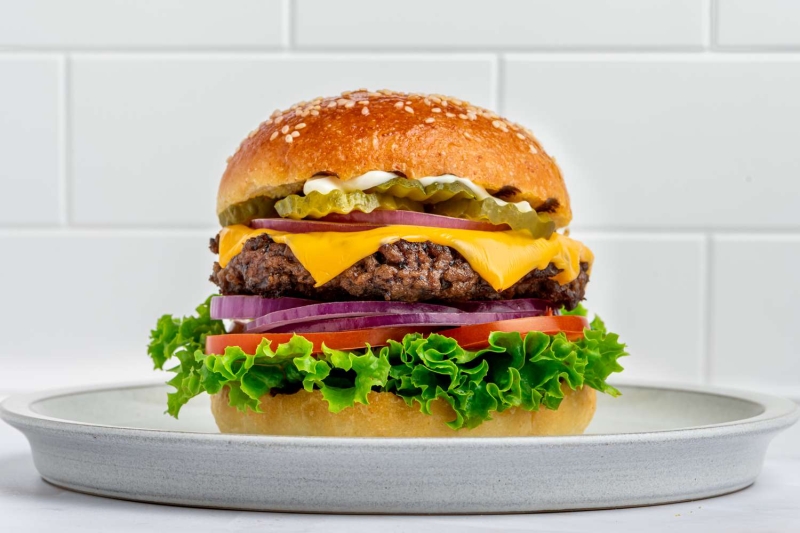It’s easier than you think.
Prep: 5 mins
Cook: 10 mins
Total: 15 mins
Servings: 4 servings
Yield: 4 burgers
If you’re new to grilling or just new to grilling burgers you’re probably feeling a little overwhelmed by the firehose of information available. You’ll read about endless hacks and gimmicks for grilling the best burger, and if you’re like me you might walk away feeling even less sure about what to do than when you started.
But I’m here to deliver some good news: the best burger is really simple. In my testing, I found that every time I tried to complicate things in search of a better burger, it just didn’t pay off. A really great grilled burger is all about the beef and the char. Season it simply, handle it minimally, and cook it hot and fast and you’re well on your way to the ideal burger.
What Kind of Beef To Buy
Most supermarket meat counters offer ground beef by fat percentage. 80/20 (80 being the percent of lean and 20 of fat) and 93/7 are the most widely available ratios for ground beef. Since your goal with a grilled burger is succulence (how “juicy” the burger is) and a nice charred crust on the outside, you want a higher percentage of fat in the meat.
The fat will prevent the meat from drying out and becoming dense and some of it will render, dripping into the flames and causing small flare ups. Flare ups are sometimes a bad thing, but small, controlled flare ups give grilled burgers their characteristic flavor, so a little fire is exactly what you want. Very lean ground beef won’t provide enough fat to make a perfectly juicy, charred burger, so stick with the 80/20 lean to fat ratio and you’re well on your way to a great burger.
How Much Ground Beef Per Burger?
The amount of meat to use per serving for a great burger really depends on what you’re going for. Smash burgers cooked on a griddle need less meat than a thick pan-roasted restaurant-style burger.
For a great grilled burger, you want to aim in between these two extremes. When you’re going for a good balance of char and juiciness, one-third pound per patty is perfect. This is enough beef to make a patty that won’t feel paltry once it’s on the bun, but not so much that the burger won’t cook evenly or is too bulky.
What do we have against thick burgers? In theory, nothing, but there is a sweet spot for burger thickness when you’re cooking on the grill. You want a burger thick enough to hold together but not so thick that it takes a long time to cook to doneness. When you’re grilling over hot, direct heat you risk burning a thick burger in the time it takes to cook it through.
What Is the Best Way to Shape Burgers?
There is a wide range of opinions on the best way to shape burgers, but thankfully the easiest method is the best. Just grab two deli lids (the round plastic lids from takeout soup containers that are flat on the bottom and have a lip on the top) and place your portioned ground beef on top of one of them (the lip should face up). Then place the second lid lip-side down and press until the patty is even. That’s it.
If you don’t have deli lids, just use your hands! Handling the meat as little as possible, shape the beef into a patty that is one-quarter to one-half inch wider than your buns (the patty will shrink a little during cooking). Form the patty so there is an indentation in the center and a half-inch rim around the edge. This prevents the patty from shrinking dramatically and puffing up in the middle. You do not need to form indentations in patties shaped using deli lids.
There is only one downside to the hand-shaped method: as the burgers cook, fat tends to pool in the indentation on top. When you flip the burgers this can cause flare ups. The best way to handle this is to lift up the burger patty with a grilling spatula and tilt it over the cooler side of the grill so any accumulated fat can drain off without flaming. Then you can flip the burger back over the coals or the flame and cook the second side.
How Do You Season Burgers Before Grilling?
The only thing good ground beef needs is salt and pepper sprinkled on the outside of the patty right before grilling. Some people like to mix seasonings into their ground beef before forming it into patties, but there’s good reason to keep it simple.
While many cuts of meat benefit from being salted ahead of time—even a day or two in advance of cooking—burgers are not one of them. Salt draws moisture out of the meat. If you’re cooking a thick ribeye, salting the meat a day ahead gives that moisture time to seep out of the meat, dissolve the salt, and then be reabsorbed, resulting in a steak that is seasoned inside and out.
However, ground meat behaves differently than steaks. Seasoning the ground beef before shaping the patties will result in a final burger texture that is bouncy, like sausage, instead of one that is tender and yielding.
I don’t even recommend salting the shaped patties in advance, as it will draw out moisture, making it harder to get a nice char on the grill.
Do You Put Oil on Burgers Before Grilling?
In short, no. There just isn’t any reason to. You should be using a relatively fatty ground beef for the best flavor and texture (and to get those nice little flare ups that put the char in chargrilled). Beef with a decent amount of fat does not need more oil and will have enough fat not to stick to the grill grate.
How Do You Keep Burgers Juicy on the Grill?
There are a few best practices for grilling burgers that will make for the juiciest patties.
- Minimal mixing—When shaping burgers, don’t handle them too much. When you mix or knead ground meat, a protein called myosin forms. This is why sausages in casings have their characteristic bouncy texture: the meat has been kneaded or mixed. Handling the meat a little is fine because a little myosin development will prevent your burgers from falling apart. Too much handling can result in a burger with the texture of a sausage.
- Don’t fuss with them on the grill—As you stand over the grill waiting for your food to cook, it’s tempting to poke, prod, and flip things over and over just to have something to do with your hands. Resist! While flipping a burger a few times isn’t a big deal, you want to leave it alone long enough to char (especially if you’re going for grill marks). And for heaven’s sake, do not smash your burgers. Smash burgers are a thing, and they can be fantastic, but smashing your grilled burger will squeeze out moisture and could even cause the patties to break apart.
- Avoid overcooking—I know, it sounds obvious, but it’s easy to do. Especially if you’re grilling at a cookout with lots going on, it’s easy to get distracted and just plain overcook your burgers. Plant your feet in front of the grill and pay attention. If you need another beer, send someone to grab one for you. Stop scrolling and put your phone away. The grillmaster should not be multitasking. The steaks are too high (heh).
Should You Rest a Burger?
Most cuts of meat benefit from resting. Large roasts should rest for up to 30 minutes, and smaller cuts should get at least a five to 10-minute rest. This process allows the juices in the meat to redistribute and for carryover cooking to finish cooking the meat to a perfect doneness.
But again, burgers are a different beast. All but the thickest burgers simply do not need resting time. For one, they’re so thin that any difference between rested and unrested is imperceptible. For another, you’ll likely end up “resting” them unintentionally anyway.
In the time between the burger coming off the grill and each diner assembling their burger, at least five minutes will likely elapse, meaning your burgers are rested without you even trying. In other words, don’t sweat it.
10 Tips for Making Your Best Backyard Burger
- Don’t go lean—Use 80/20 ground beef for juicy, tender burgers.
- Make the perfect sized patties—1/3 pound ground beef per burger is the perfect amount.
- Don’t overwork the meat—When shaping burgers, handle the meat as little as possible.
- Shape burgers the easy way—Use two deli lids to shape burgers with ease. If you don’t have deli lids, shape burgers slightly larger than the buns with a depression in the center and a 1/2-inch rim around the edge.
- Keep seasonings simple—Use only salt and pepper to season the outside of your burgers and season them right before cooking.
- Keep the meat cold—Keeping the ground beef cold ensures the fat will not start to melt before cooking, and you’ll have a better chance at getting a medium rare interior and a nicely charred exterior.
- No oil needed—You do not need to put oil on burgers before grilling.
- Cook them hot and fast—Let burgers cook over hot direct heat for 4 to 5 minutes before you try to flip them. When they’re ready to flip, they should release easily from the grill.
- Don’t fear the fire—Small grill flare ups give burgers a beautiful charred flavor, but quash big flare ups with a squeeze bottle filled with water.
- No resting required—You do not need to rest burgers. Serve them right away.
What To Serve With Burgers
Any good cookout should have potato salad or a macaroni salad if potatoes aren’t your thing. While you’re grilling, you may as well throw on some corn on the cob or corn ribs. For a refreshing side dish, consider a juicy watermelon salad or tangy slaw.
«There’s nothing quite like a well-seasoned, perfectly grilled burger! I used a gas grill set for high direct heat, and my burgers took about 9 minutes to cook. They were slightly over 145 F, but they were still incredibly juicy. To avoid sticking, make sure you don’t try to flip them too early.» —Diana Rattray
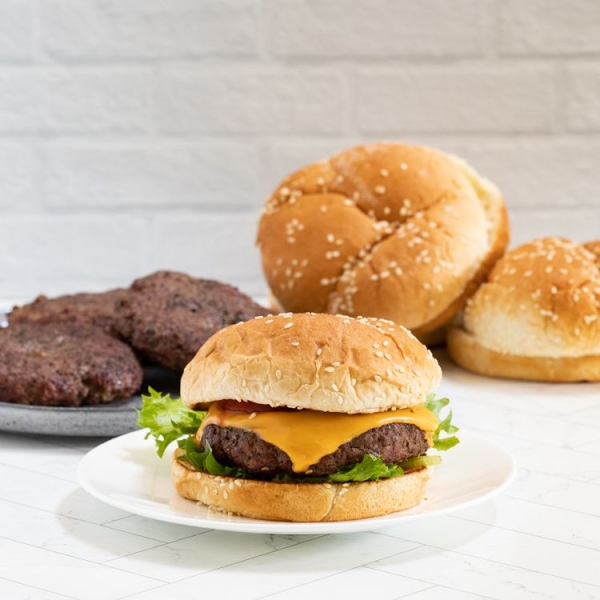
A Note From Our Recipe Tester
Ingredients
-
1 1/3 pounds (21 ounces) cold ground beef (80 percent lean)
-
1 1/2 teaspoons fine salt
-
1 teaspoon freshly ground black pepper
-
4 sesame burger buns
-
4 to 8 slices American cheese, optional
-
Optional toppings: mayonnaise, leaf lettuce, sliced tomato, sliced onion, pickles
Steps to Make It
-
Gather the ingredients. Heat a gas grill on high for 10 minutes with the lid closed or prepare a hot charcoal grill fire.
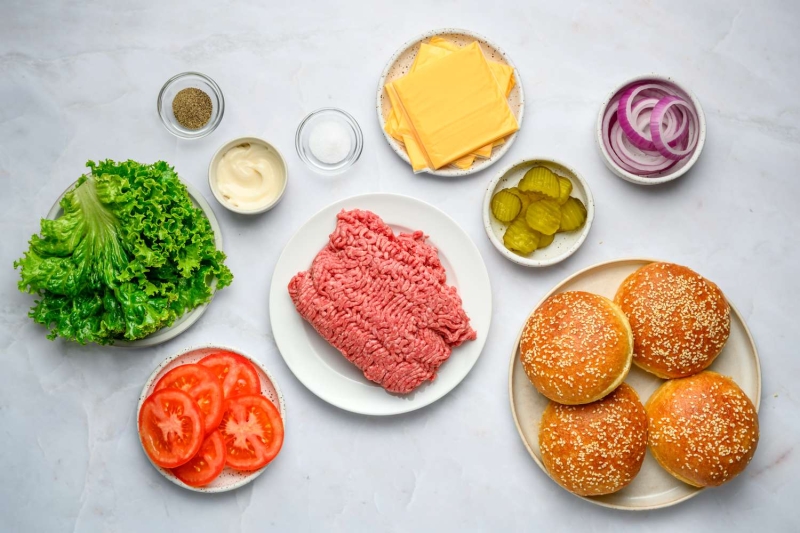
-
Meanwhile, divide 1 1/3 pounds (21 ounces) cold ground beef (80 percent lean) into 4 equal portions and shape the meat into patties that are wider than your buns (the burgers will shrink a bit during grilling). If you have two deli lids, use those to form the patty. Otherwise, form the patties so there is a depression in the center with an approximately 1/2-inch wide rim around the edge. Handle the meat as little as possible.
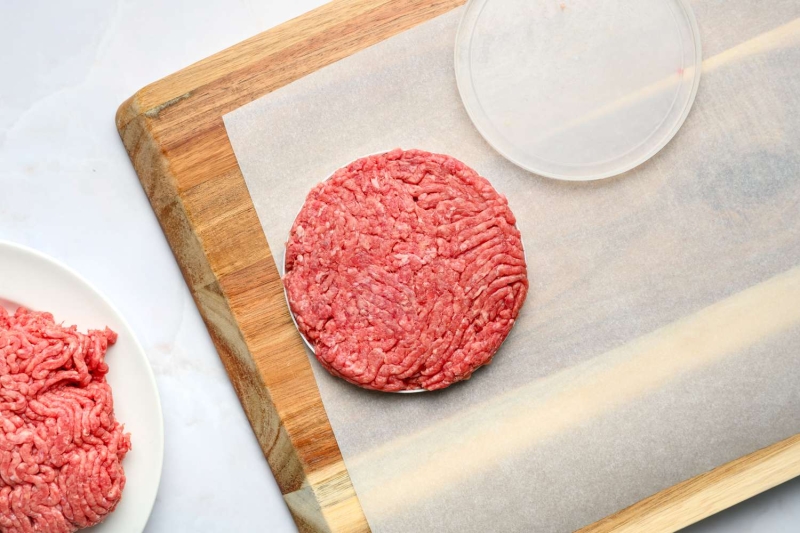
-
Season the burger patties with 1 1/2 teaspoons fine salt and 1 teaspoon freshly ground black pepper on both sides.
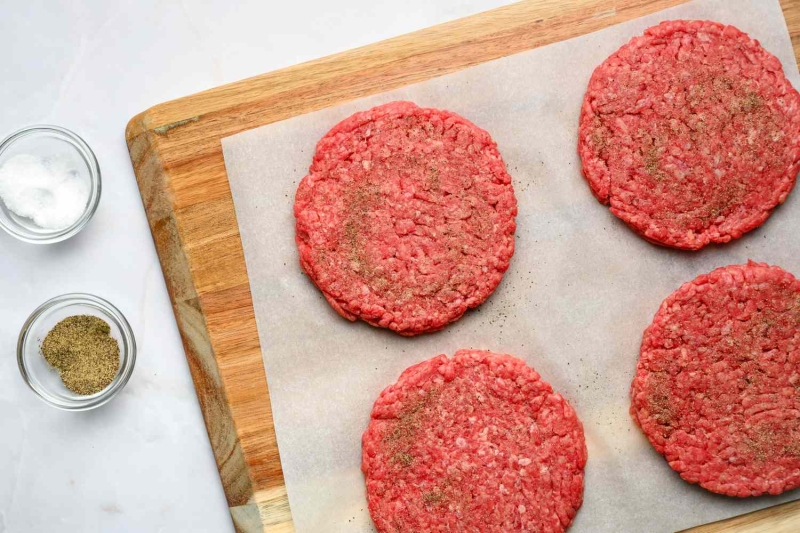
-
When the grill is ready, place the burgers over direct heat and let sit without flipping or moving until nicely charred and the patties release easily from the grill grate, 4 to 5 minutes. The burgers should release easily from the grill. If you try to flip them and they’re sticking, wait another minute or so.
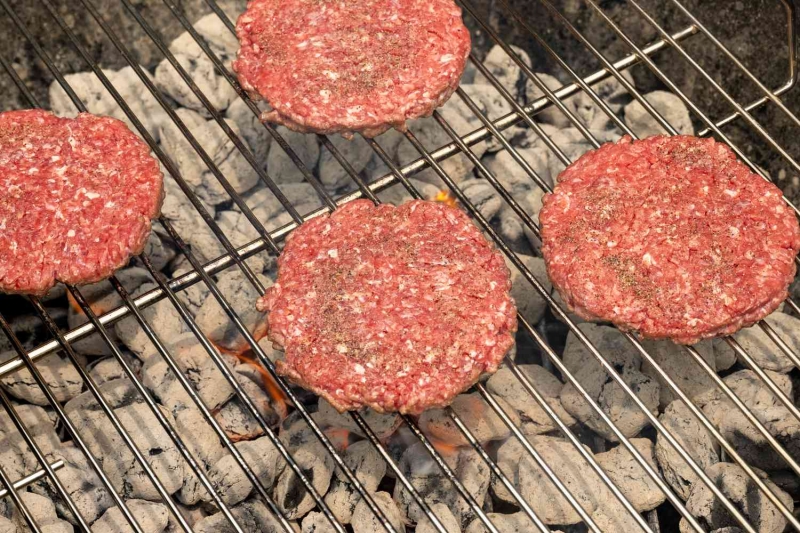
-
Flip the burger patties and cook, undisturbed, for 4 to 5 minutes more or until cooked to your liking (use a thermometer if needed: the internal temperature should be 135 F for medium-rare burgers or 145 F for medium).
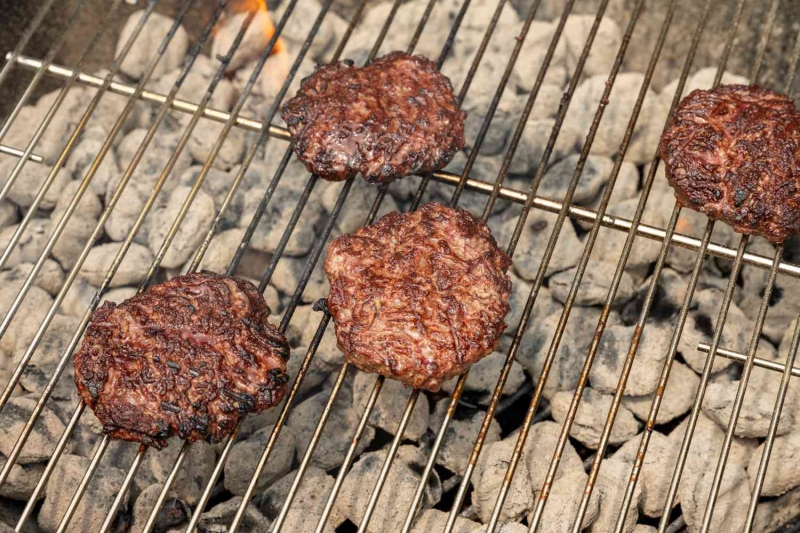
-
In the last minute or so of cooking, place 4 sesame burger buns on the grill to toast and place 1 or 2 slices of the 4 to 8 slices American cheese, if using, on top of each burger patty to melt.
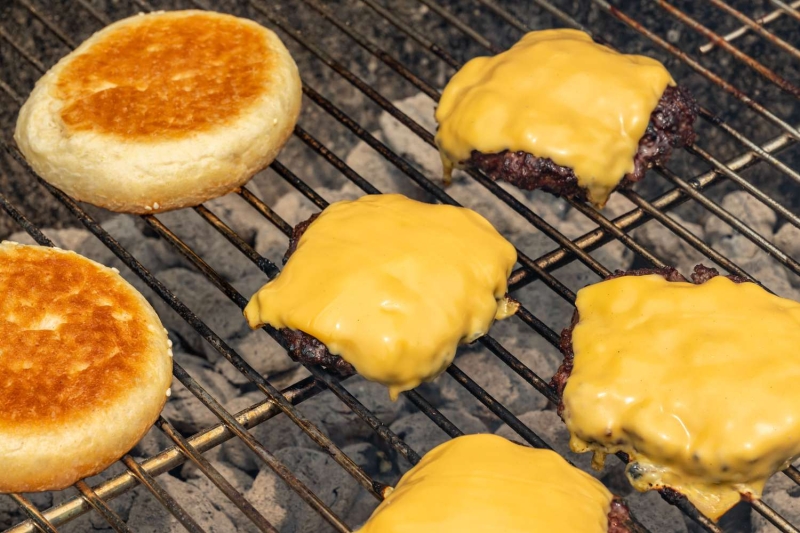
-
Serve the burgers right away on the toasted buns with your choice of optional toppings: mayonnaise, leaf lettuce, sliced tomato, sliced onion, and/or pickles.
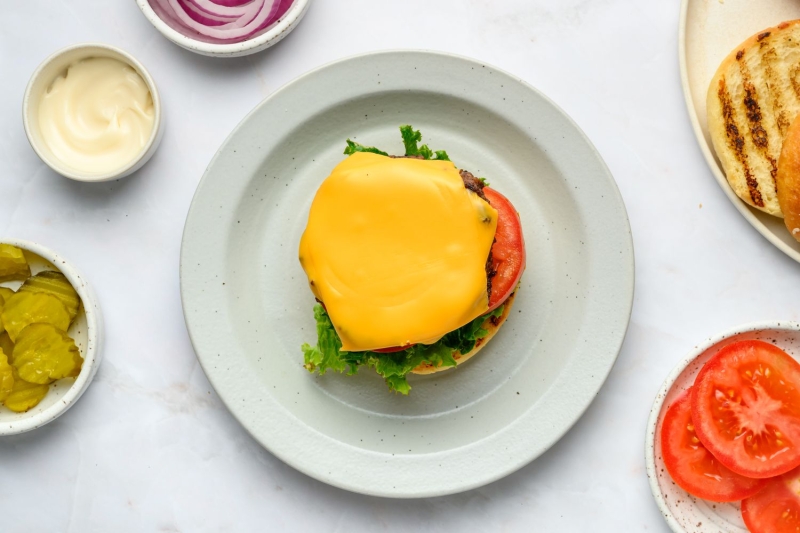
How To Store
Grilled burgers are best eaten right after cooking, but if you’ve grilled a bunch for a party and have some left over, keep the patties refrigerated in an airtight container for up to four days. Reheat them gently in a covered skillet with a little water to create steam so they don’t dry out.
| Nutrition Facts | |
|---|---|
| Servings: 4 | |
| Amount per serving | |
| Calories | 452 |
| % Daily Value* | |
| Total Fat 21g | 27% |
| Saturated Fat 8g | 39% |
| Cholesterol 99mg | 33% |
| Sodium 1160mg | 50% |
| Total Carbohydrate 27g | 10% |
| Dietary Fiber 1g | 4% |
| Total Sugars 3g | |
| Protein 35g | |
| Vitamin C 1mg | 3% |
| Calcium 126mg | 10% |
| Iron 5mg | 28% |
| Potassium 498mg | 11% |
| *The % Daily Value (DV) tells you how much a nutrient in a food serving contributes to a daily diet. 2,000 calories a day is used for general nutrition advice. | |
